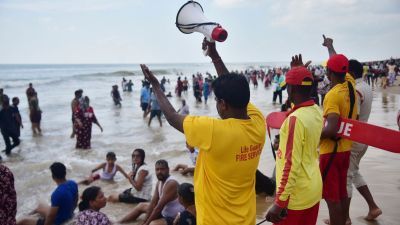People on the edge
Those living on the zigzag Indo-Bangladesh border are afraid the planned barbed-wire fence would leave them out of India
Joykanta Barman,74,a subsistence farmer,head of a joint family of nine,is confused and angry. The boundary line between India and Bangladesh runs along the edge of his house. Barman had learnt to live with it until he heard of the governments plan to erect a fence that might leave his entire village of 86 houses outside India. How can this be allowed? We have been living here for more than 14 generations,and you want to push us out into Bangladesh? says Barman.
A barbed-wire fence being erected 150 metres inside the Indian territory all along the border with Bangladesh in Assam,Meghalaya,Tripura,Mizoram and West Bengal will leave hundreds of Indian villages out. Barmans village,Durganagar,is one of 19 such villages in Cooch Behar district of West Bengal.
At present,international border is the line one can imagine between pillars that dot the countryside herepillar number 960 is right in front of Barmans house,and across the road is Bhothaat,a Bangladeshi village.
It is the governments headache how they construct the fence. Even now we are exposed to dacoity and theft and what not because of the open border. Once they erect the fence and leave us out,we will be looted and killed in broad daylight, Barman says. However,hundreds of families located on the zero line have been shifted,while hundreds more are waiting.
Barman and his fellow villagers are not the only victims of this quirk of history. Residents of Chota Garaljhora,a few kilometres northeast of Durganagar,are caught in a more peculiar situationthe village protrudes into Bangladesh like a balloon. It has an 18.9-km barbed-wire fence around it,except for a 300-metre opening that connects it with the rest of India through a 400-metre long corridor just 23 metres wide at the narrowest point.
The road that connects Chota Garaljhora to Digaltari is about 2.5 km long and has remained kutcha since 1947. The fencing on the two sides of the corridor is not allowed because international protocol does not permit such a construction within 150 metres of the zero line. Thus,the residents are not only exposed to all kinds of trans-border crimes despite having a fence almost all around their village,they are also deprived of electricity since electric poles cannot be installed so close to the border.
Pillar No 977/7-S is right on the edge of my land. Protecting the cows has been a problem here for decades. There have been instances of people from the other side reaping away our harvest at night. But what can I do? I cant leave my ancestral land and run away, says Kasem Ali,38,father of four children. And,because the corridor is so narrow,we are also deprived of a health centre, adds Asadul Sheikh,47,another villager. The village,however,has a primary school,but those in higher classes have to travel at least 10 km to the nearest high school. The nearest government hospital is about 23 km away,and the nearest bus stop is at a distance of eight km.
Paresh Chandra Rai-Sinha,60,of Digaltari village,an amin who measures land for the revenue department,says,We keep hearing about the government taking steps to complete the barbed-wire fence all along the border. Then we hear of objections from the other side. Often news also comes that several villages like Durganagar will be left outside once the fence comes up. I dont think I will be able to see some settlement in my lifetime.
The Border Security Force (BSF) officials say the enclave dwellers are in a state of statelessness with no basic amenities. Some of these enclaves,both on the Indian and Bangladeshi sides,are safe havens for smugglers. But the BSF cannot enter these enclaves because of technical reasons, says an officer. BSFs seizure and apprehension records indicate as much. Cross-border crimes are more in the Coochbehar sector (171.315 km border,of which 24.085 km are riverine) due to these enclaves as well as villages that are located right on zero linethis despite joint patrolling by BSF and the Border Guards of Bangladesh.
The boundary being so zigzag that there is no scope for erecting a fence inside 150 metres from the zero line here. While the narrowest stretch of the corridor connecting Chota Garaljhora is 23 metres,there are some enclaves connected by stretches that are just 10 metres wide, says the BSF official.
What makes the problem even worse is that several enclaves on either side of the border are not connected to their countries. Dakhin Masaladanga is a 160-acre Bangladeshi enclave inside India with about 600 inhabitants. Close by is Paschim Masaladanga,a 35-acre enclave,and three othersPurba Masaladanga No 1,No 2,and No 3all belonging to Bangladesh but with no inhabitants. The BSF allows Bangladeshis from across the zero line to come in to cultivate their lands.
Prime ministers of both countries had last year signed a protocol for exchange of 162 such enclaves,but that has yet to become a reality. We want an early settlement. More than 65 years have passed since Independence and creation of East Pakistan which in 1972 became Bangladesh,but our fate is still uncertain, says Kasemer Sheikh,70,of Chota Garaljhora.






- 01
- 02
- 03
- 04
- 05

























